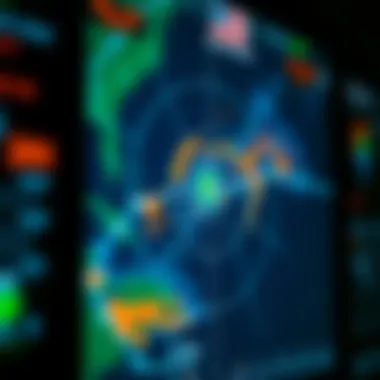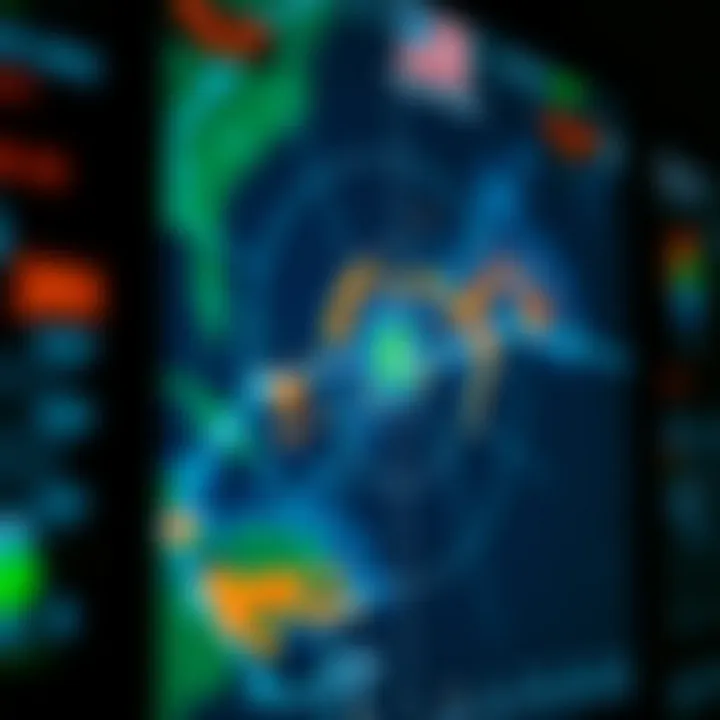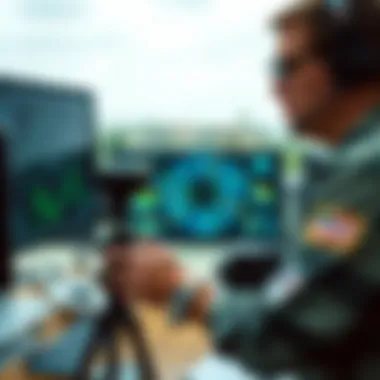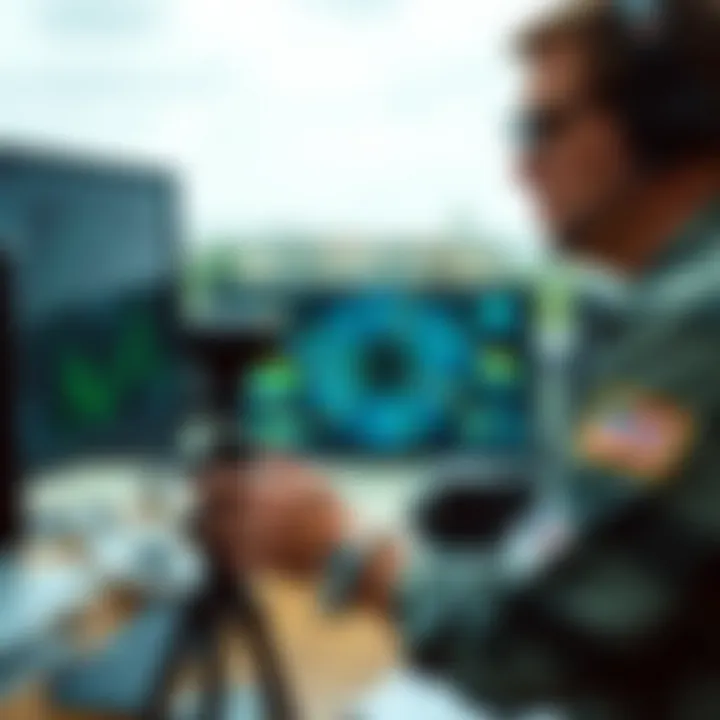Decoding Weather Channel Radar for Tampa's Climate


Intro
When it comes to enjoying outdoor activities like kiteboarding, understanding the weather is half the battle. If you're in Tampa, you're well aware of the unpredictability of its climate. The tropical environment can change in the blink of an eye, making it essential for enthusiasts to keep an eye on radar systems. One resource that many rely on is the Weather Channel, a stalwart in providing real-time weather updates.
In this article, we focus on how weather radar works and its specific applications for Tampa's unique weather depiction. From grasping the mechanics of radar technology to interpreting live data, we'll unlock everything you need to know for a smooth kiteboarding experience. So grab your gear; let’s dive deep into the fascinating world of weather radar and how it can enhance your outdoor adventures.
Gear and Equipment
Having the right gear is crucial for ensuring safety and making the most of your kiteboarding experience. Whether you’re a novice or an experienced rider, knowing what to pack can improve your time on the water. Let’s break down the essential equipment every kiteboarder should consider.
Essential Kiteboarding Gear for Beginners
If you’re just starting out, investing in the right equipment can make the learning curve less steep. Here’s a list of must-have items:
- Kite: A beginner-friendly kite is typically smaller and more stable in various wind conditions. Look for brands like Naish or North that offer solid beginner options.
- Board: Select a board that is wide enough to provide stability but not too heavy, so you can maneuver easily. Consider a twin-tip board for its versatility.
- Safety Gear: Don’t skimp on a good personal flotation device (PFD) and a helmet. Safety should always come first, especially for newcomers.
- Harness: A comfortable harness that fits well will help distribute the pull across your body.
Advanced Equipment for Experienced Riders
For those who have honed their skills and are ready to take it up a notch, investing in specialized equipment can make a significant difference.
- High-Performance Kites: Choices like the Slingshot Rally or the Cabrinha Switchblade offer advanced features for experienced riders seeking thrills.
- Kiteboard: A directional board could be your next step if you're interested in surfing-style how your kiteboarding. These boards are more specialized and designed for wave riding.
- Bar and Lines: Upgrading to a high-quality bar with improved control and responsiveness can enhance your performance.
Techniques and Tips
Having the right gear is just one piece of the puzzle; putting it to good use with effective techniques is where the magic happens. Here’s what you need to know.
Basic Riding Techniques for Newbies
For newcomers to kiteboarding, mastering the fundamentals is paramount. Here are some basic techniques:
- Body Dragging: Practice this technique by letting the kite pull you through the water without your board. It's crucial for learning control.
- Water Start: This is the transition from floating in the water to riding up on your board. Starting in the correct position and using the kite to lift yourself is key.
- Steering and Control: Familiarize yourself with how your kite reacts to different inputs. Small adjustments can lead to significant changes in your trajectory.
Expert Tricks to Elevate Your Skills
Once you’ve mastered the basics, it’s time to shine with some techniques that can elevate your kiteboarding performance:
- Kite Loops: To gain speed and control, perform kite loops while maneuvering your board.
- Jumping: Combine speed with the right timing to launch yourself into the air effortlessly. It’s exhilarating to feel the rush of air beneath you.
- Transitions: Work on switching direction while keeping your speed, helping you ride fluidly through different wind conditions.
Remember, every expert was once a beginner. Diligent practice and familiarization with the weather patterns can significantly enhance your skills and safety.
By understanding both how the Weather Channel's radar operates and perfecting your technique with the right equipment, you'll be well-prepared for whatever conditions Tampa throws your way. Weather should never be an enemy; instead, it’s a partner in your kiteboarding journey.
Prelude to Weather Radar
Understanding weather radar is crucial for anyone living in or visiting areas with significant weather fluctuations, particularly in Tampa. With its subtropical climate and proximity to the Gulf of Mexico, Tampa stands as a prime example of how regional weather phenomena require sophisticated monitoring. In this section, we will explore the fundamental aspects of weather radar technology. The benefits of grasping this topic stretch beyond mere curiosity; they can significantly impact the planning of outdoor activities, safety during inclement weather, and even local businesses reliant on weather forecasts.
Weather radar serves as a telescope for meteorologists, revealing not just rain or storms but offering insight into wind patterns and atmospheric conditions. For kiteboarders and outdoor enthusiasts, understanding radar not only means anticipation of enjoyable conditions but also positions them to avoid potentially dangerous weather.
By delving into this segment of our discussion, we lay the groundwork for comprehending how technology evolves and its practical applications in everyday life. This understanding proves valuable, especially when one ventures into the unpredictability of the outdoors.
The Evolution of Weather Radar Technology
Weather radar technology has significantly advanced since its conception. The journey began in the late 1930s, primarily utilized for military defense purposes. As World War II unfolded, radar systems took center stage, detecting enemy aircraft and movements. Realizing the technology’s potential, scientists redirected focus towards meteorology during post-war years, setting the stage for forecasting our weather.
Over the decades, there has been a continuous refinement of these systems. Early weather radars operated solely at low frequencies, which made detecting smaller precipitation patterns difficult. Today, with improvements in antenna design and digital processing, weather radar can identify not just rain but also hail, sleet, and even tornadoes.
Notable advancements include:
- Doppler Radar: Introduced in the late 20th century, it enabled the analysis of movement within the atmosphere. This technology assists in predicting severe weather events, allowing for timely alerts.
- Dual-Polarization Radar: Unlike traditional radar, it sends out dual pulses, yielding greater detail about precipitation types.
- Integrated Radar Networks: These align multiple radar sites to provide comprehensive coverage, essential for areas like Tampa, where localized severe weather can pop up unexpectedly.
Each upgrade not only enhances accuracy but also boosts public safety—a critical aspect in a time when unpredictable weather patterns become the norm.
Understanding Radar Waves
At the heart of weather radar technology lies the interaction of radar waves with atmospheric elements. Simply put, radar waves are emitted from a radar dish, and when they encounter precipitation, they bounce back to the receiver. This is where the real identification begins. The time taken for the waves to return helps determine the distance of the weather phenomena, while the strength of the returned signal reveals the intensity of precipitation.
Key concepts include:
- Wavelength: Weather radars use different wavelengths, typically in the microwave range, to optimize detection capabilities. Short wavelengths are great for detecting small raindrops, while longer wavelengths handle larger droplets effectively.
- Signal Transmission and Reception: The radar transmits pulses of energy, which are then returned to the radar system upon striking moisture in the air. Analyzing these reflections gives data on storm location and intensity.
- Radio Frequency Interference: Sometimes, signals can mix with other frequencies resulting in noise. Understanding this interference helps meteorologists separate signal from noise, ensuring accuracy in readings.
By familiarizing ourselves with radar waves, we unlock a fundamental component of interpreting weather data—essential for those who venture out into the unpredictable skies of Tampa.


The Weather Channel: Overview
When discussing weather radar systems, particularly in relation to Tampa, it’s crucial to grasp the role played by The Weather Channel. This network has become not only a resource for tracking storms but also a hub for weather education and awareness. Understanding their offerings gives kiteboarders and outdoor enthusiasts valuable insights, including how conditions might impact their activities. With Tampa’s dynamic climate, having reliable and detailed weather information can make all the difference between a great day on the water and a potentially hazardous situation.
History and Development
The Weather Channel has been a staple for weather updates since its inception in 1982. Founded by meteorologist John Coleman, it aimed to provide 24-hour weather coverage. Fast forward to today, and the channel has evolved markedly. Initially, it relied heavily on static radar images. However, advances in technology have ushered in real-time data that keeps viewers informed as situations unfold.
In Tampa, where summer thunderstorms can erupt unexpectedly, having a reliable weather source becomes essential. The channel has managed to stay relevant by embracing digital transformations and integrating advanced radar technologies. Their journey reflects a commitment to constantly improving weather forecasting abilities, which is invaluable for those needing precise data for outdoor activities like kiteboarding.
Key Features and Offerings
The Weather Channel stands out for several key features that are particularly beneficial for residents and visitors in Tampa:
- Interactive Radar Maps: Users can access a user-friendly interface showing precipitation levels, storm paths, and the direction of winds. This interactivity helps outdoor enthusiasts, particularly kiteboarders, assess the weather before heading out.
- Local Weather Alerts: Customized notifications are available based on user location, ensuring that people stay informed of severe weather developments.
- Expert Analysis and Forecasts: The meteorologists provide detailed forecasts that go beyond simple temperature readings. They analyze trends, helping viewers understand possible weather impacts.
- Mobile Accessibility: The Weather Channel app gives on-the-go weather updates right at the users’ fingertips, making it easier for kiteboarders to check conditions before planning their day out.
With these factors in mind, The Weather Channel becomes more than just a weather service; it’s a partner for outdoor enthusiasts navigating Tampa's unique climate challenges. This understanding is particularly crucial as weather changes can happen in the blink of an eye, impacting not just the experience but overall safety while kiteboarding.
"Weather is what you expect, climate is what you get." Understanding these concepts is vital for kiteboarders catering their outings to Tampa's ever-changing patterns, which The Weather Channel helps to illuminate.
Tampa's Unique Weather Patterns
Tampa, situated on Florida's Gulf Coast, is known for its distinct weather patterns that play a crucial role in various outdoor activities, including kiteboarding. Its seasonal changes and geographical positioning create a unique climate that has essential implications for weather forecasting. Understanding these weather patterns is not just vital for daily planning but also for enthusiasts looking to optimize their adventures. This section delves into the geographical influences and seasonal variations that form the backbone of Tampa's weather dynamics.
Geographical Influences
The geographical makeup of Tampa significantly influences its weather. Nestled between the warm waters of the Gulf of Mexico and rolling hills to the east, Tampa experiences a moderate climate that contrasts sharply with other regions. The proximity to the Gulf contributes to high humidity levels, which in turn affect local weather phenomena.
Furthermore, Tampa's coastal location means it is often at the mercy of tropical storms and hurricanes during the storm season. This factor makes it imperative for residents and visitors alike to stay informed using reliable radar services like those provided by the Weather Channel.
Key geographical factors to consider include:
- Proximity to Water: Tampa's coastal nature brings moist air that enhances cloud formation and precipitation.
- Elevation Issues: While largely flat, slight elevations to the east can create microclimates, leading to variation in local weather patterns.
- Urban Heat Island Effect: As the city grows, areas of asphalt and concrete can raise local temperatures slightly, affecting localized weather conditions.
Navigating these geographical influences will make adventurers better equipped when grasping Tampa's ever-changing weather outlook.
Seasonal Variations
Like clockwork, Tampa undergoes seasonal shifts that further illustrate the variability of its weather system. From sweltering summers to mild winters, each season brings its own unique characteristics.
- Summer (June to August): Dominated by heat and humidity, the summer features frequent thunderstorms, often in the form of sudden downpours. Kiteboarding during this time can be exhilarating but requires caution due to unpredictable gusts.
- Fall (September to November): This season might see remnants of tropical storms, but it also provides some of the best conditions for kiteboarding as temperatures begin to cool down. The winds start to become more consistent and manageable for those looking to ride the waves.
- Winter (December to February): Winters in Tampa are quite mild and temperate, with lower humidity and cooler temperatures. This time is ideal for outdoor activities as the clear skies and predictable weather patterns make it a favored season for kiteboarders.
- Spring (March to May): As spring approaches, temperatures rise again, and humidity begins to set in. While warm winds can create enjoyable kiteboarding conditions, sudden storms can return with a vengeance, emphasizing the importance of keeping an eye on the radar.
Understanding these seasonal variations and their implications on activities like kiteboarding can enhance one's experience on the water. By leveraging the Weather Channel’s radar features, kiteboarders can make informed decisions that ensure a safe and enjoyable outing.
How Weather Radar Works
Understanding how weather radar functions is crucial, particularly in a weather-diverse place like Tampa. It’s not just about visuals; it’s about harnessing technology to make informed decisions—especially for those looking to kiteboard or simply enjoy the great outdoors. With Florida’s unpredictable weather patterns, knowing how radar operates could be the difference between enjoying a sunny kiteboarding experience or being caught in a downpour.
Basic Principles of Radar Functionality
Weather radar works by sending out radio waves into the atmosphere. When these waves hit precipitation particles—such as raindrops or snowflakes—they bounce back to the radar device. The time it takes for this echo to return provides invaluable information about the distance and intensity of the weather phenomena. Quite simply, it’s like sending out a shout and listening for the reply.
The strength of the echo received helps meteorologists determine how heavy the precipitation is. The process itself is known as the reflectivity of radar, essentially measuring the amount of energy returned to the radar. This helps build a picture of the storm’s structure, guiding forecasts that are especially critical in regions like Tampa, which can go from calm to stormy in the blink of an eye.
Types of Radar Systems
There are several types of radar systems used in meteorology, each with unique attributes that aid in weather forecasting:
- Standard Radar: This is the basic system that provides general information about rainfall. Perfect for day-to-day forecasts.
- Doppler Radar: It detects velocity, helping meteorologists understand not just where precipitation is, but how it's moving. Crucial for tracking tornadoes—something Tampa residents don't take lightly.
- Dual-Polarization Radar: This newer technology sends out waves both horizontally and vertically, which can distinguish between types of precipitation more effectively, thus enhancing forecast accuracy.
Having multiple types of radar allows forecasters to compile a comprehensive view, ensuring outdoor enthusiasts are informed and safe.
Doppler Effect in Weather Radar
The Doppler Effect plays a fundamental role in modern meteorology. When you hear about Doppler radar, it's not just a fancy term thrown in to impress; it essentially refers to the change in frequency of the radar waves based on the movement of precipitation.
- If rain or storm systems are moving towards the radar, the frequency of the returned waves increases; conversely, if they are moving away, the frequency decreases. This enables meteorologists to measure not only the intensity but also the movement direction and speed of storms.
Through this powerful tool, forecasters can provide accurate alerts, helping kiteboarders to determine safe hours for their adventures. Weather patterns in Tampa can shift quickly, hence understanding the Doppler Effect remains vital for anyone relying on timely and precise weather updates.
"Using radar effectively is like having a front-row seat to nature's own light show, allowing us to predict its next act with pinpoint accuracy."


In sum, understanding the workings of weather radar gives kiteboarders and outdoor lovers keen insights into the skies above them. By recognizing radar's basic principles, the various types utilized, and the innovative Doppler Effect, one can appreciate the role these technologies play—especially in areas with dynamic weather like Tampa.
Viewing the Weather Channel Radar for Tampa
When it comes to navigating the complexity of Tampa's weather, having immediate access to reliable weather radar is essential. The Weather Channel radar provides a comprehensive view of what’s brewing in the atmosphere, thus giving kiteboarders and outdoor enthusiasts the crucial edge they need. It’s not just about knowing if it’s going to rain or shine; it’s about understanding the intricate patterns that influence wind and climate specifics in the region. By leveraging this technology, users can make informed decisions that directly affect their experiences outdoors.
Accessing the Radar Interface
The first step in harnessing the power of the Weather Channel radar is to access the radar interface itself. This user-friendly platform can be navigated through the Weather Channel’s website or mobile app. Here’s how you can get started:
- Visit the Website: Go to weather.com or download the Weather Channel app from your device's app store.
- Location Setting: On the website or app, enter "Tampa" in the search bar. This tailors the radar view to your specific location.
- Navigate to Radar Options: Once you're on the Tampa weather page, look for a menu or tab labeled "Radar". Here, you will find a variety of radar layers and settings.
The interface might seem daunting at first, but do not fret; each feature is geared towards enhancing your weather comprehension. Options such as precipitation type or storm tracking can be toggled, allowing tailored visualization based on individual needs. Whether you are waiting for the right winds for kiteboarding or planning a beach day with the family, familiarizing yourself with these options can prove beneficial.
Interpreting Radar Images
Once you’ve accessed the radar images, understanding how to read them effectively is the next critical step. Avoiding misinterpretation can save you from unexpected weather surprises. Here are some guidelines to make sense of what's displayed:
- Rainfall Intensity: Shades of green, yellow, and red represent various intensities of precipitation. Light green may indicate light rain, while darker shades (red) reveal heavy rainfall, which could affect outdoor activities significantly.
- Motion and Direction: The radar images update in real-time, allowing you to visualize how storm fronts are moving across the Tampa area. This provides crucial information about when rain or wind might hit your selected spot.
- Storm Tracks: Most interfaces will display storm tracks, which highlight potential paths of severe weather. This can help you gauge whether or not you should postpone your plans.
Understanding these basics can transform how you interact with weather radar, truly making it a tool for your advantage in decision-making.
By systematically dissecting the radar images and familiarizing yourself with the interface, you'll not only improve your own outdoor adventures but also enhance the safety and enjoyment of those around you.
Real-Time Weather Tracking
Real-time weather tracking has transformed the way we interact with the natural elements around us. For those in Tampa, this isn’t just about staying dry during Florida's notorious afternoon storms; it’s about navigating every breeze and gust that can make or break a kiteboarding adventure. The immediacy of real-time updates ensures that outdoor enthusiasts have their fingers on the pulse of changing conditions.
Benefits of Real-Time Weather Tracking
Efficient weather tracking means that updates appear almost instantaneously, providing essential data on temperature fluctuations, wind speeds, and storm trajectories. Here are a few key benefits to consider:
- Safety First: Knowing when the weather is about to take a turn can help kiteboarders avoid potentially hazardous conditions.
- Optimal Timing: Enthusiasts can time their sessions precisely when winds are strongest and most favorable, allowing for better performances on the water.
- Local Insights: Real-time data gleaned from Tampa’s specific conditions can differ significantly from broader forecasts, ensuring tailored information for those who know the local terrain.
"Real-time tracking is like having a weather scout right in your pocket, ready to alert you when the winds pick up or when a storm brews nearby."
Of course, the key to leveraging real-time weather tracking lies in choosing the right platforms and tools that deliver accurate information. Not all weather applications provide real-time data, making it crucial to rely on established services like Windy or the National Weather Service, which offer the most reliable insights.
Updating Weather Conditions
As any experienced kiteboarder will tell you, conditions can shift quicker than a wink. The updating weather conditions feature is a game-changer, offering live feeds that let you know what’s coming your way at any given moment. This continuous stream of information is vital for making those split-second decisions that are often required when you’re out on the water.
For instance, if a storm cell begins to form to the east of Tampa, spotting that through a reliable weather channel radar can mean the difference between a successful day on the water or being forced to fold up your gear early. Updates often include:
- Changes in wind direction and speed.
- Precipitation forecasts that give kitesurfers a heads-up.
- Temperature updates to ensure safety and comfort.
With such immediacy, outdoor lovers can adjust their plans in an instant, ensuring not a moment of precious kiteboarding time is wasted.
Alerts and Notifications
In the realm of kiteboarding, timely alerts become a lifeline. Integrated alerts and notifications are like having a seasoned coach whispering in your ear—"Hey, the wind’s picking up! Get ready!" Weather services now allow users to set personalized alerts for different weather events, particularly crucial for Tampa's variable wind patterns.
These notifications can be received via your smartphone or other devices, providing key insights such as:
- Weather warnings about high winds, storms, or even flooding.
- Customized alerts that focus solely on wind speeds relevant to kiteboarding, meaning notifications aren't cluttered with irrelevant information.
- Regular updates enabling users to plan their sessions versus those unexpected shifts in weather.
All in all, having access to alerts ensures that kiteboarders can make the most out of their time on the water. It helps in planning trips and activities better, allowing for a seamless integration of adventure and safety.
For anyone that loves to hit the waves, staying on top of weather conditions is critical. As Tampa’s weather evolves, those equipped with timely information can navigate the windy swells with confidence.
The Impact of Weather on Kiteboarding
Kiteboarding is not just a sport; it's a finely-tuned dance with nature. The importance of understanding how weather affects kiteboarding cannot be overstated. Variables such as wind speed, direction, temperature, and precipitation play pivotal roles in a kiteboarder's experience on the water. When conditions align just right, it can make for the perfect day out. However, misunderstandings or neglect of certain weather aspects can lead to unsafe situations, turning the thrill into a perilous venture.
Here are some pivotal elements kiteboarders need to consider:
- Wind Dynamics: Wind is the lifeblood of kiteboarding. Understanding local wind patterns can drastically improve a kiteboarder's skills and safety. Seasonal shifts can bring unpredictable wind behavior, particularly in regions like Tampa, which experiences varied climatic influences.
- Weather Forecast Accuracy: Relying on real-time weather data from reliable sources like the Weather Channel can make a world of difference. This is particularly crucial in a city like Tampa, where sudden changes in weather can quickly alter conditions on the water. Being flagged to an approaching storm or sudden gusts in wind can be the difference between a thrilling ride and an accident.
"The wind is not merely a factor, it’s the essence of kiteboarding; respect it, and you'll ride the waves with joy. Disregard it, and you risk more than just a disrupted outing."
Understanding the interplay of these factors not only enhances performance but also emphasizes the necessity for education in understanding weather data.
Wind Patterns and Kiteboarding Safety


When it comes to kiteboarding safety, knowledge of wind patterns is paramount. Tampa's coastal geography heavily influences its wind behavior. The winds are often consistent during certain months, with summer afternoons frequently ushering in reliable breezes that beckon kiteboarders to the water.
However, not all winds are created equal. Shifty winds, for instance, tend to change direction quickly and can catch inexperienced kiteboarders off guard. Understanding how to read these patterns can help.
For a successful kiteboarding session, it’s vital to:
- Monitor Wind Speeds: Ideally, breezes should range from 12 to 25 knots. Less than that, and you might be waiting on the water; more than that, and it can become dangerous, particularly for less-experienced riders.
- Identify Offshore Winds: Offshore winds can create a false sense of security. They prevent the wind from moving onshore, leading to unexpected challenges and potential hazards.
- Check Local Flags: Many kiteboarding spots, including Tampa's, will often display flags that indicate current wind conditions. Always respect these indicators.
Choosing the Right Time to Board
Selecting the best time for kiteboarding can optimize your experience. In Tampa, this involves much more than just looking at basic wind reports. Seasonality, tide schedules, and local competitions can all affect conditions on the water.
Some key considerations for determining timing:
- Time of Year: Spring and fall often yield the most reliable winds. Summers can be tricky with sporadic thunderstorms, while winters may offer quieter conditions.
- Tidal Activity: Tides can dictate access to certain spots and impact the water’s surface conditions. Riding during the incoming tide might mean smoother waters, as opposed to the turbulent aftermath of a receding tide.
- Event Clashes: Local kiteboarding events can draw crowds, making your outing busier than usual. Off-peak times often provide a more serene experience and lessen the likelihood of accidents.
By factoring in these weather influences, kiteboarders can not only improve their outings but also ensure they remain safe while pursuing their passion.
Understanding Weather Data
Weather data serves as the backbone of forecasting, particularly when understanding the subtle nuances of Tampa's climate. Comprehending this data empowers kiteboarders, outdoor enthusiasts, and travel bloggers alike, granting them the ability to make informed decisions related to their activities. From predicting the likelihood of rain to clarifying wind conditions, each piece of data plays its part in the grander scheme of weather functionality.
Deciphering Meteorological Terms
Weather data is esoteric by nature; each term often wears a mask that can unsettle even the most seasoned of weather-watchers. Familiarizing oneself with these terms can greatly enhance one’s understanding of forecasts.
- Front: This is a boundary between two air masses. It can lead to either stormy weather or a beautiful sunny day, depending on its characteristics.
- Precipitation: This refers to any form of water, liquid or solid, that falls from the atmosphere. Rain, snow, sleet, and hail all fall under this category.
- Barometric Pressure: A measurement of the weight of the air above us. A drop in pressure often means a storm is brewing, while a rise can indicate fair weather.
Once you know the lingo, interpreting data like radar images and forecasts becomes much simpler. For instance, when you see a tornado watch, understanding the definition means knowing there’s a probability of a tornado occurring.
The Role of Temperature and Humidity
Temperature and humidity are like two dancers in a duet, essential for predicting weather patterns. Their interplay determines not just comfort levels but also safety for outdoor activities.
- Temperature Regulation: In Tampa, temperatures can swing dramatically from day to night, affecting kiteboarding conditions. Understanding daily temperature ranges can help in deciding the best time for flying kites.
- Humidity Levels: High humidity can sap the energy right out of you and make it feel much hotter than it really is. On the other hand, low humidity can accelerate drying, impacting surface water conditions relevant for kiteboarding.
- Impact on Weather Systems: Humidity is crucial for forming rain clouds. An uptick in humidity could signal the approach of a storm, while stable, lower humidity can indicate a clear day ahead.
"Weather doesn’t just happen; it’s a symphony of atmospheric conditions, and to appreciate this performance, one must learn to read the sheet music."
In essence, a thorough grasp of weather data—those meteological terms and the roles temperature and humidity play—enables enthusiasts to pick up on signs that influence their outdoor plans. In the world of kiteboarding, where conditions can shift faster than one can say "lets hit the waves," making sense of this data is not just helpful but essential.
Future Technologies in Weather Radar
As we venture deeper into the realms of weather radar science, the topic of future technologies holds immense significance, particularly for areas like Tampa, where unique climatic patterns demand precise forecasting. Innovations in this field are not only enhancing the accuracy of weather predictions but are also influencing various activities, such as kiteboarding, which relies heavily on weather conditions. Here's a closer look at some of the upcoming advancements that are shaping the future of weather radar technology.
Advancements in Meteorological Instruments
The landscape of meteorological instruments is steadily evolving. Consider, for instance, the introduction of phased array radar systems. Unlike traditional radar that scans the atmosphere in a sweeping motion, phased array systems utilize a more sophisticated approach by electronically steering the beam across the sky. This allows for quicker updates and finer resolution, thus providing a more detailed picture of storm dynamics and weather phenomena.
Another significant leap is the incorporation of smartphone-enabled meteorological stations. These devices can measure localized weather conditions, feeding real-time data back to central systems. With Tampa’s unpredictable weather, such localized instruments can play a crucial role. They can monitor microclimates that often wreak havoc on kiteboarding plans. Thus, enthusiasts can make informed decisions by accessing hyperlocal data on wind speed, humidity, and temperature.
The integration of satellite technology is another important development. Enhanced satellites equipped with advanced sensors offer a broader perspective of atmospheric conditions. These instruments can detect subtle changes that ground-based radar might miss, giving users a fuller understanding of incoming weather patterns. By utilizing satellite data alongside ground-based radar, meteorologists can produce more reliable forecasts, which is essential for both casual beachgoers and serious kiteboarders alike.
AI and Predictive Modeling
Artificial intelligence is taking the world by storm, and weather radar is no exception. The potential of AI in predictive modeling can significantly improve meteorological forecasting. By analyzing massive datasets gathered from radar, historical data, and real-time observations, AI systems can identify patterns and trends that may not be immediately apparent to human analysts.
For example, machine learning algorithms can be trained on past weather events to predict future occurrences with remarkable accuracy. In Tampa, where sudden storms may develop quickly, these predictive models can help kiteboarders avoid risky conditions, ensuring their safety while enjoying the sport.
Furthermore, AI-controlled systems can automate the process of alerting users about significant changes in weather. For kiteboarding enthusiasts, receiving timely alerts about wind speed fluctuations or impending thunderstorms can be the difference between a day spent on the water or a hasty retreat to dry land.
"The future of weather radar technology is bright, powered by advancements in instruments and the integration of AI, ensuring that users are equipped with the best possible data for their activities."
The End
The importance of understanding weather radar, particularly in the context of Tampa, cannot be overstated. It serves as a crucial resource for those who live in or visit the area, especially kiteboarders and outdoor enthusiasts who rely heavily on accurate weather forecasts. Tampa's unique climate presents specific challenges and opportunities that radar technology aims to navigate. Through a thorough understanding of radar systems and their functionalities, individuals can make informed decisions that significantly enhance their experience.
Summarizing Key Insights
- Weather Complexity in Tampa: The region's weather is influenced by various geographical factors, leading to fluctuations that can change swiftly. Weather radar provides real-time data that helps users stay ahead of these changes.
- Radar Interpretation: Understanding radar images is vital. They provide information about precipitation, storm direction, and intensity. Analyzing these factors allows for better preparation and safety measures.
- Continuous Evolution: Technology is not static. As weather radar improves, so do its applications in forecasting weather phenomena. Kiteboarders and outdoor enthusiasts should keep abreast of these advancements for enhanced safety and enjoyment.
Recommendations for Kiteboarders
- Monitor the Radar Regularly: Given Tampa's unpredictable weather, it's wise for kiteboarders to check the Weather Channel radar frequently. This step ensures awareness of any sudden storms or changes in wind conditions that could impact safety.
- Learn Radar Basics: Familiarizing oneself with how to interpret radar images can lead to better decision-making before heading out. Recognizing features like storm cells, moisture, and wind direction can be a game changer.
- Utilize Notifications: Take advantage of real-time notifications from weather apps. These alerts can provide timely updates on changing conditions, allowing kiteboarders to respond quickly to new threats or optimal conditions.
- Plan Wisely: Always have a backup plan in case weather conditions are not favorable. Considering alternate times for kiteboarding can help one make the most of the available weather, ensuring an enjoyable and safe experience.
"Understanding the weather is like knowing the secret handshake of an old club; it's less about the knowledge and more about applying it wisely in real-time."
Tampa offers a rich experience for outdoor activities, but navigating its complex weather patterns requires informed decisions fueled by radar technology. By staying informed and prepared, enthusiasts can enjoy everything this vibrant area has to offer.















